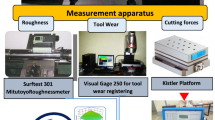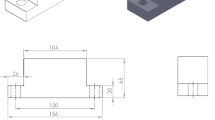Abstract
Clinching joint quality and functionality may have undesirable features because of the choice of the forming process parameters. In fact, there are different factors controlling the mechanical connection strength such as the tools’ geometry and the joint final shape. This paper presents the implementation of the Taguchi-based Grey optimization of the mechanical clinching with fixed dies for dissimilar materials (Aluminum alloy 7075 and Mild Steel) to derive the optimal process parameters combination that leads to a high strength connection subjected to multiple characteristics, namely, the bottom thickness, the interlock length, and the neck thickness of the joint. LS-DYNA explicit and implicit finite element (FE) software was used to simulate the process in order to evaluate the joint strength by loading the sheets vertically. Taguchi’s L27 orthogonal array design and the notion of signal-to-noise (S/N) ratio were utilized to obtain the objective function. Analysis of variance (ANOVA) showed the importance of factors on overall output. The output of the study provided the optimal geometrical parameters of the punch, die, and blank holder. Indeed, the die groove height, die diameter, punch diameter, punch corner radius, and clearance between punch and blank holder were found to be the most influential parameters on the bottom and neck thicknesses. In addition, the output indicated that when bottom thickness or neck thickness increased, the interlock decreased.
Similar content being viewed by others
References
Lambiase F (2013). Influence of process parameters in mechanical clinching with extensible dies. Int J Adv Manuf Technol (66):2123–2131
Eshtayeh MM, Hrairi M, Mohiuddin AKM (2015) Clinching process for joining dissimilar materials: state of the art. Int J Adv Manuf Technol. doi:10.1007/s00170-015-7363-0
Lambiase F, Di Ilio A (2013) Finite element analysis of material flow in mechanical clinching with extensible dies. J Mater Eng Perform 22(6):1629–1636
Varis J (2006) Economics of clinched joint compared to riveted joint and example of applying calculations to a volume product. J Mater Process Technol 172(1):130–138
Mori K, Abe Y, Kato T (2012) Mechanism of superiority of fatigue strength for aluminium alloy sheets joined by mechanical clinching and self-pierce riveting. J Mater Process Technol 212:1900–1905
He X, Zhang Y, Xing B, Gu F, Ball A (2015) Mechanical properties of extensible die clinched joints in titanium sheet materials. Mater Des 71:26–35
Neugebauer R, Kraus C, Dietrich S (2008) Advances in mechanical joining of magnesium. CIRPAnnals - Manuf Tech 57(1):283–286
Lambiase F (2015) Joinability of different thermoplastic polymers with aluminium AA6082 sheets by mechanical clinching. Int J Adv Manuf Technol. doi:10.1007/s00170-015-7192-1
Lee S-H, Lee C-J, Lee K-H, Lee J-M, Kim B-M, Ko D-C (2014) Influence of tool shape on hole clinching for carbon fiber-reinforced plastic and SPRC440. Adv Mech Eng 2014:1–12
Mucha J (2011) The analysis of lock forming mechanism in the clinching joint. Mater Des 32(10):4943–4954
Lambiase F (2015) Clinch joining of heat-treatable aluminum AA6082-T6 alloy under warm conditions. J Mater Process Technol 225:421–432
Abe Y, Mori K, Kato T (2012) Joining of high strength steel and aluminium alloy sheets by mechanical clinching with dies for control of metal flow. J Mater Process Technol 212(4):884–889
Abe Y, Kato T, K-i M, Nishino S (2014) Mechanical clinching of ultra-high strength steel sheets and strength of joints. J Mater Process Technol 214:2112–2118
Lambiase F, Ilio AD, Paoletti A (2015) Joining aluminium alloys with reduced ductility by mechanical clinching. Int J Adv Manuf Technol 77:1295–1304
Lee C-J, Kim J-Y, Lee S-K, Ko D-C, Kim B-M (2010) Parametric study on mechanical clinching process for joining aluminum alloy and high-strength steel sheets. J Mech Sci Technol 24(1):123–126
Oudjene M, Ben-Ayed L (2008) On the parametrical study of clinch joining of metallic sheets using the Taguchi method. Eng Struct 30(6):1782–1788
Abe Y, Kishimoto M, Kato T, Mori K (2009) Joining of hot-dip coated steel sheets by mechanical clinching. Int J Mater Form 2(1):291–294
Oudjene M, Ben-Ayed L, Delameziere A, Batoz J-L (2009) Shape optimization of clinching tools using the response surface methodology with Moving Least-Square approximation. J Mater Process Technol 209(1):289–296
Lambiase F, Di Ilio A (2013) Optimization of the clinching tools by means of integrated FE modeling and artificial intelligence techniques. Procedia CIRP 12:163–168
Zhao L, He XC, Lu Y (2014) Research of mechanical behavior for rounded and rectangular clinched joint. Adv Mater Res 1035:144–148
Lambiase F, Di Ilio A (2014) An experimental study on clinched joints realized with different dies. Thin-Walled Struct 85:71–80
He X, Zhao L, Yang H, Xing B, Wang Y, Deng C, Gu F, Ball A (2014) Investigations of strength and energy absorption of clinched joints. Comput Mater Sci 94:58–65
He X, Liu F, Xing B, Yang H, Wang Y, Gu F, Ball A (2014) Numerical and experimental investigations of extensible die clinching. Int J Adv Manuf Technol 74(9-12):1229–1236
Meyer PL (1970) Introductory probability and statistical applications, 2nd edn. Addison Wesley, Reading, MA
Mehat NM, Kamaruddin S (2011) Multi-response optimization of injection moulding processing parameters using the Taguchi method. Polym-Plast Technol 50(15):1519–1526
Datta S, Bandyopadhyay A, Pal PK (2008) Grey-based Taguchi method for optimization of bead geometry in submerged arc bead-on-plate welding. Int J Adv Manuf Technol 39(11-12):1136–1143
Mondal S, Paul C, Kukreja L, Bandyopadhyay A, Pal PK (2013) Application of Taguchi-based gray relational analysis for evaluating the optimal laser cladding parameters for AISI1040 steel plane surface. Int J Adv Manuf Technol 66(1-4):91–96
Pan LK, Wang CC, Wei SL, Sher HF (2007) Optimizing multiple quality characteristics via Taguchi method-based Grey analysis. J Mater Process Technol 182(1):107–116
Tzeng C-J, Lin Y-H, Yang Y-K, Jeng M-C (2009) Optimization of turning operations with multiple performance characteristics using the Taguchi method and Grey relational analysis. J Mater Process Technol 209(6):2753–2759
Echrif SB, Hrairi M (2014) Significant parameters for the surface roughness in incremental forming process. Mater Manuf Process 29(6):697–703
Author information
Authors and Affiliations
Corresponding author
Rights and permissions
About this article
Cite this article
Eshtayeh, M., Hrairi, M. Multi objective optimization of clinching joints quality using Grey-based Taguchi method. Int J Adv Manuf Technol 87, 233–249 (2016). https://doi.org/10.1007/s00170-016-8471-1
Received:
Accepted:
Published:
Issue Date:
DOI: https://doi.org/10.1007/s00170-016-8471-1




